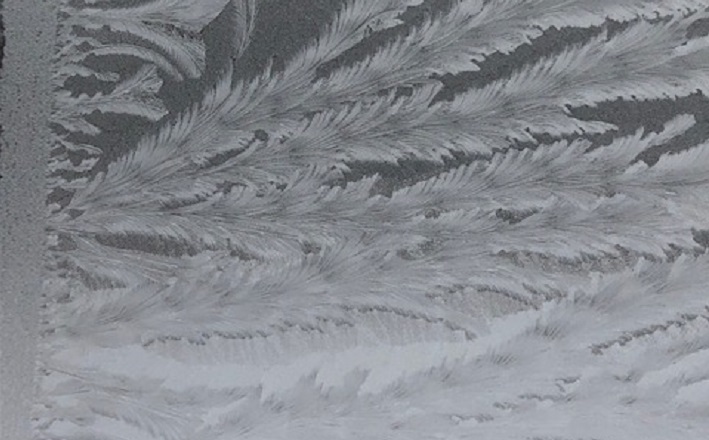As I write in February, awaiting spring, Easter, and Earth Day (April 22), outside it is 18 degrees, cloudy and dark.
Snow and sleet cover the air, the ground, and the solar panels; the pond is thick with ice. In anticipation of single digits, my spouse and I created a homemade heating system for the greenhouse to protect our winter greens. And, as if it knows what the greenhouse is for, frost on the windows has assumed the unexpected visage of unfurling ferns, anticipating the vegetative growth that will soon appear.
Some seasons it is easier to carry hope than others. Last year, we are told, was yet again one of the warmest on record, capping off a decade of relentlessly deteriorating climatic conditions. Ironically, the forces that brought a sweltering summer have also wrought another polar vortex, rendering pandemic precautions even harder as the virus mutates into more dangerous forms.
And yet, like the hope of spring, we also see glimmers of global progress, redemptive acts, shifting human history. COVID vaccines are rolling out. The U.S. has rejoined the Paris Climate Accord. More federal lands are becoming protected from environmental degradation. Industries are leading: General Motors announced its all-electric vehicle future; asset manager BlackRock adopted a climate-focused investment strategy; coal-fired power plants are closing—even in coal-producing states—and all over the world; renewable energy and energy efficiency are growing exponentially. Faith-based earth care continues to rise. It is as if we were living through the longest Easter vigil ever.
The first thing the Bible tells us on page 1 is that God created the world, its features, and its creatures, and seven times called them good (Genesis 1:4, 10, 12, 18, 21, 25, 31). Page 2 (Genesis 2:15) describes the vocation God gave to humankind to till and keep—or, more accurately, to serve and preserve the land. Genesis 3:17-19 and Genesis 4:1-16 recount the breakdowns occurring almost immediately with the land, one another, and God, and begin the story of the blunders polluting both the earth and our own well-being. The rest of the Bible, and the rest of faith history, narrate the divine project of redeeming humanity from such blunders, long-arced divine redemption that might just make us whole again. In patience, God promised never to destroy the earth again with a flood, but did not promise to keep us from destroying ourselves. It’s up to us, with God’s guidance, to make that promise and live into it.
With the spring come new opportunities to choose how we humans will treat creation. With Easter comes the remembrance of God’s redeeming us despite ourselves. With Earth Day comes the chance both to celebrate the world’s splendor and to revitalize our own pledges to our descendants, pledges to live out our first vocation of serving and preserving God’s earth. As faith leaders and spokespeople, how will we spread the good news this season?
March 7, 2021 – Third Sunday in Lent
- Psalm 19 describes how the mute skies, which moderns consider inanimate, proclaim a living word.
March 14, 2021 – Fourth Sunday in Lent
- Numbers 21:4-9 shows a deadly serpent in the wilderness becoming a sign of healing.
- Psalm 107:1-3, 17-22 describes God’s healing of sick people, who were growing “near to the gates of death” (verse 18).
- John 3: 14-21 presents Jesus coming so that those who believe “may not perish but may have eternal life” (verse 16).
March 21, 2021 – Fifth Sunday in Lent
- Jeremiah 31:31-34, Psalm 51, and Hebrews 5:5-10 all describe deep metanoia as changes in heart through learned obedience.
- John 12:20-33 explains Jesus’ own death, and with it the death of many people and movements: “Unless a grain of wheat falls into the earth and dies, it remains just a single grain; but if it dies, it bears much fruit” (verse 24).
March 28, 2021 – Sunday of the Passion (Palm Sunday)
- Isaiah 50:4-9a portrays the prophet describing himself as awakened daily to listen to God.
- Psalm 31: 9-16 describes seeking divine deliverance from scorn and horror, from being forgotten “like one who is dead.”
- Philippians 2:5-11 describes Jesus’ having set the example for Christians by humbling himself, obedient even to the point of death
- Mark 14:1-15:47 tells the story of the woman who, anointing Jesus with pure nard, “anointed my body beforehand for its burial” (verse 8).
April 4, 2021 – Easter
- Acts 10:34-43 recounts Peter’s realizing for the first time that Jesus “is Lord of all” (verse 36).
- Isaiah 25:6-9 envisions a mountaintop where God alleviates hunger, swallows up death, and wipes away sorrow. Within three verses (verses 6-8), the word “all” (kol) is repeated five times: “all peoples (twice),” “all nations,” “all faces,” “all the earth.”
- John 20:1-18 tells of Mary Magdalene’s mistaking the risen Jesus for a gardener—an image with high overtones, given the creation stories’ attention to gardening.
April 11, 2021 – Second Sunday of Easter
- Acts 4:32-35 describes shared ownership among early followers. As a result, no one goes hungry.
- Psalm 133 exuberantly celebrates the gift of living together, comparing it to anointing with precious, priestly oil, and to the dew of the far-off mountainside of Hermon.
April 18, 2021 – Celebration of Earth Week
- Acts 3:12-19 depicts Peter—who has just restored the health of a man begging for money—confronting the hypocrisy of those who surround him, whom he says “killed the Author of life,” and calling them to repentance.
- Psalm 4, in the face of adversaries who “seek after lies,” ponders faithful trust in God.
- 1 John 3:1-7 calls sin “lawlessness” and ponders what righteousness means.
- Luke 24:36b-48 depicts Jesus appearing among the disciples and offering peace and understanding.
April 25, 2021 – Fourth Sunday of Easter
- Psalm 23 and John 10:11-18 both draw upon shepherding imagery to describe trust in God’s provision for all needs.
- 1 John 3:16-24 instructs the audience to carry out God’s generosity by providing for the needs of brothers and sisters, loving “not in word or speech, but in truth and action.”
Patricia Tull’s bimonthly Working Preacher column, “The Great Community,” focuses on ecological themes for preaching.

